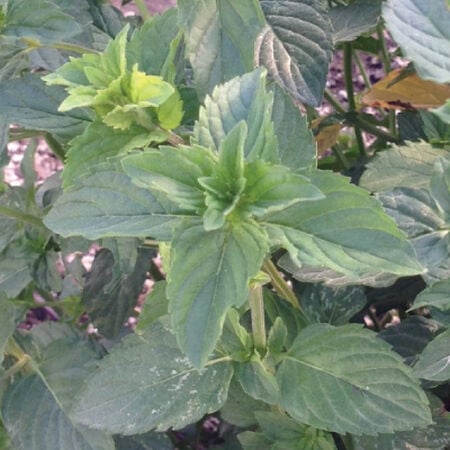Spearmint, Mint Seed
Key Attributes
Key Attributes
Product Details
Weight
0.008Depth
0.1Height
4.5Width
3.25Plant Height
12-24"Botanical Name
Mentha spicataSeed Type
SeedSeeds Per Gram
10,999Seeds Per Pound
4,987,200Packet
250 SeedsSow Depth
Top of SoilSeeds Per Ounce
311,700Breed
Open-pollinatedSun
Full SunGrowing Conditions
Container FriendlyLife Cycle
PerennialSow Method
TransplantCategories
HerbGermination
11,12,13,14,15,10Days To Maturity (# Days)
70-90Components
Growing Instructions
![]() Learning Download: How to Grow Mint
Learning Download: How to Grow Mint
The two most commonly grown mint plants are spearmint and peppermint. Mint is generally used as a garnish or to flavor dishes, but it can also be a fragrant addition to any garden.
Before Planting: Mint grows best in full sun or partial shade and when planted in
organically rich soil.
Planting: Sow seeds indoors 10 weeks before the last frost or direct sow them outdoors in April or May. Plant seeds ¼ inch deep. If starting indoors, incorporating heat from the bottom will quicken the germination process. When moving mint outdoors, space the plants up to 2 feet apart.
Watering: Water regularly, 3 to 4 times a week.
Fertilizer: Since mint spreads so quickly, it is best to fertilize the plant only if it is in a container or a bed bordered by metal or plastic. For mint in a container, apply an all-purpose liquid fertilizer in the spring when new growth appears on the plant. Fertilize every four to six weeks, as frequent watering can wash away the nutrients.
Days to Maturity: Mint is generally ready to harvest once the plant has begun to flower. (See each variety for days to harvest)
Harvesting: Mint is a hardy plant that grows back quickly, so clip the leaves or entire branches as you need them throughout its growing season.
Tips: Mint spreads quickly due to its root system and can easily get out of control, which makes it do well in containers where its roots are limited in where they can grow.
Shipping Schedule
Our Seed Promise
 "Agriculture and seeds" provide the basis upon which our lives depend. We must protect this foundation as a safe and genetically stable source for future generations. For the benefit of all farmers, gardeners and consumers who want an alternative, we pledge that we do not knowingly buy or sell genetically engineered seeds or plants.
"Agriculture and seeds" provide the basis upon which our lives depend. We must protect this foundation as a safe and genetically stable source for future generations. For the benefit of all farmers, gardeners and consumers who want an alternative, we pledge that we do not knowingly buy or sell genetically engineered seeds or plants.
The mechanical transfer of genetic material outside of natural reproductive methods and between genera, families or kingdoms, poses great biological risks as well as economic, political, and cultural threats. We feel that genetically engineered varieties have been insufficiently tested prior to public release. More research and testing is necessary to further assess the potential risks of genetically engineered seeds. Further, we wish to support agricultural progress that leads to healthier soils, to genetically diverse agricultural ecosystems, and ultimately to healthy people and communities.
To learn more about the "Safe Seed Pledge" please visit www.councilforresponsiblegenetics.org.

